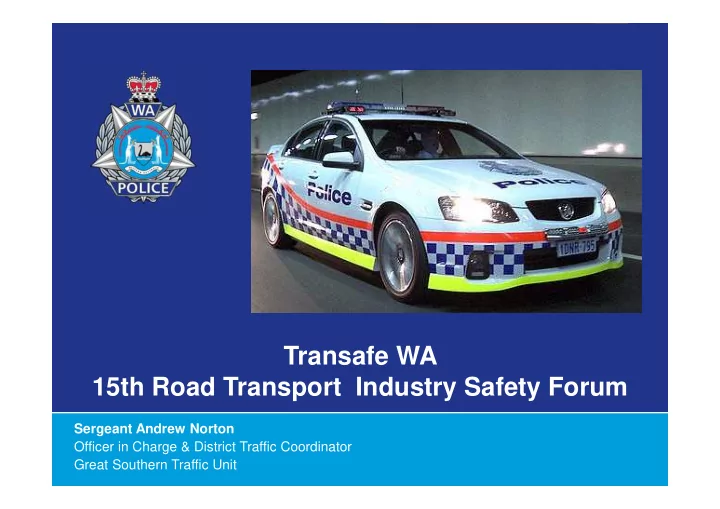

Transafe WA 15th Road Transport Industry Safety Forum Sergeant Andrew Norton Officer in Charge & District Traffic Coordinator Great Southern Traffic Unit
Great Southern District • Occupies 100’271 km 2 • 11 individual Local Government Agencies • Regional population is 77’511 (Census 2016) • 4’820 km of sealed road • 10’158 km unsealed road
Great Southern District Sealed Highways • Albany Highway • South Coast Highway • Great Southern Highway • Brookton Highway • Muir Highway • Coalfields Highway • South Western Highway There is a mix of long haul transport, seasonal tourist and commuter traffic using these roads. Heavy vehicle traffic increases significantly during the harvest season and traffic volumes vary greatly at the commencement of the agricultural areas around Albany.
Local Government Roads • Predominantly unsealed roads except within the urban centres within the Great Southern District. • These roads vary depending on topography, local environment and usage. • Subject to deterioration at flood-ways during heavy rain events. • The state default maximum speed limit is 110km/h.
Great Southern Traffic Enforcement Unit � Enforce Traffic Laws � Target Unsafe Road-User Behaviour � Build Road Policing Capability
Enforce Traffic Laws • Enhanced Speed Enforcement Aim: Achieve greater compliance with posted speed limits • Enforce Use of Restraints Aim: Increase compliance with the wearing of seatbelts and other restraints by drivers and passengers of vehicles • Impaired Driving Aim: Contribute to a reduction of the incidence of fatalities and serious injuries caused by alcohol and drug-impaired drivers • No Authority to Drive (Unlicensed Drivers) Aim: Detect and deter unlicensed drivers driving on WA roads
Target Unsafe Road-User Behaviour CATERGORY ‘A’ OFFENCES KPI OF 90% effort towards ‘Category A’ Offences : • Impaired Driving – Drugs and/or Alcohol • Reckless / Dangerous / Careless Driving • Speeding • No Authority to Drive • Mobile Phones/Non-use of Restraints
Target Unsafe Road-User Behaviour SPEEDING SEATBELT 76 Briefs/ Briefs/ 3094 Infringements Infringements Cautions Cautions 3727 212 OTHER 2194 Briefs/ Source: WA Police Infringements Cautions 4995
Target Unsafe Road-User Behaviour 212 Total Station Drug Tests ROADSIDE DRUG TESTS YTD March 2018 171 Positive Results 20 10% 17 8% STATION (EVIDENTIAL) DRUG TESTS Meth YTD March 2018 Cannabis Both 26 165 1 15% 82% Meth 1% 21 Cannabis 12% Both 124 Fail to Comply 72% 2216 Total Roadside Drug Tests 202 Positive Results *Source: WA Police - March 2017- March 2018
Build Road Policing Capability • Capacity Building Aim: Integrate road policing training into training programs for all police officers. • Driver Education Aim: Utilise traffic stops to promote driver awareness on road laws and road safety • Partnership and Community Engagement Aim: Align enforcement with Towards Zero and Office of Road Safety road user education campaigns. Contribute to the achievement of WA Police Key Performance Indicators for Towards Zero.
Fatal and Serious Crashes 351 people were killed or seriously • injured (KSI) in the Great Southern region from 2012-2016 71 people were killed or seriously • injured in the Great Southern region in 2016 . • KSI rate is 113.7 per 100,000 population. • 61% of KSI were male . • 19% of KSI were aged 17-24 year olds
Types of Crashes Most of the fatal and serious crashes that occur in the regional areas of Western Australia involve only one vehicle which has either run off the road and/or collided with an object or rolled over. 42% were single vehicle hitting an object • (excludes animals). • 21% were non-collision single vehicle rollover or run-off-road crashes. 57% occurred on 110 km/h speed zones. • 12% occurred on roads with speed zones of • 50 km/h .
Fatalities by Behavioural Factor- WA 2017 Number of Fatalities by Behavioural Factor - 2017 50 SPEED 35 ALCOHOL Source: Road Safety Commission 28 INATTENTION 16 FATIGUE 0 10 20 30 40 50 60
Fatalities by Speed Zone - WA 2017 Fatalities by Speed Zone 110kph 100kph 90kph 80kph 70kph 60kph Source: Road Safety Commission 50kph <=40kph Not Recorded 0 10 20 30 40 50 60 70
Types of Crashes in 2016 FATAL and SERIOUS INJURY CRASH TYPES - 2016 Unknown Hit Parked Vehicle Passenger Fell Sideswipe Same Direction Rear End Head On Hit Pedestrian Source: Road Safety Commission Indirect Right Angled Right Angled Non Collision Hit Object 0 10 20 30 40 50 60 70 80
KILLED and SERIOUSLY INJURED WITH HEAVY VEHICLES ONLY BY ROAD USER IN WA 2017 KSI with Heavy Vehicles Only - 2017 2.5 2 1.5 1 0.5 0 Driver Passenger Driver Passenger Driver Passenger Pedestrian Driver Passenger Pedestrian Driver Passenger Source: Main Roads WA Prime Mover Prime Mover Road Train Truck Truck & 1 & 1 Trailer Trailer Fatal Hospital Medical
Driver Behaviour For the 5 year period from 2012-2016: Seatbelts were not worn by 10% of vehicle • occupants killed or seriously injured. • Speed was a factor in the 22% of fatal and serious crashes. At least one driver/rider with a blood • alcohol concentration of 0.05 or higher was recorded in 9% of fatal and serious crashes. * • Research indicates fatigue was a factor in 23% of fatal and serious crashes. #
Great Southern Crashes CRASHES (March 2017- March 2018) 13 12% Fatal Serious 31 Injury 62 29% 59% Source: WA Police
Forgetting for a moment that every fatal crash costs over $1million… Every fatal and serious traffic crash is a tragedy that touches everyone in our communities. Please, drive safely.
Thank You
Recommend
More recommend